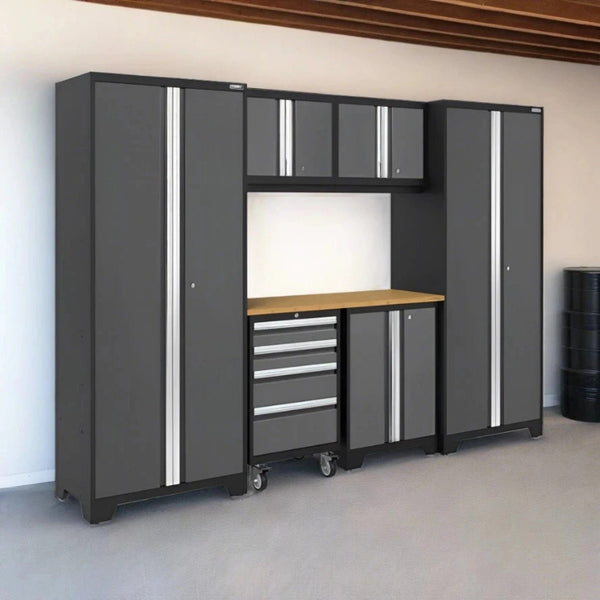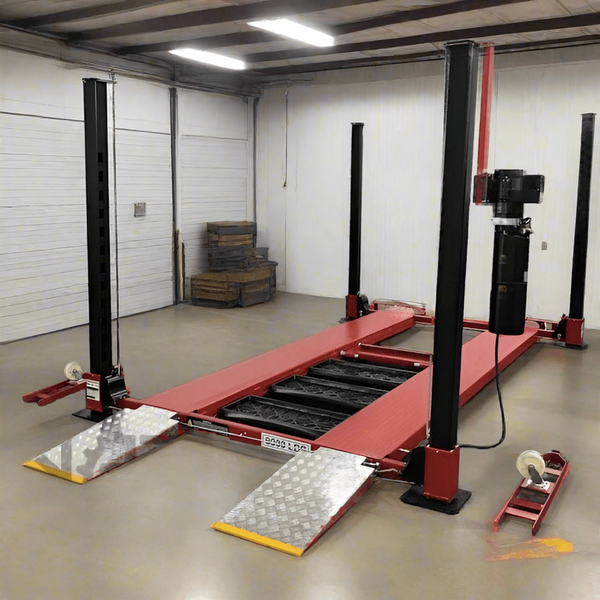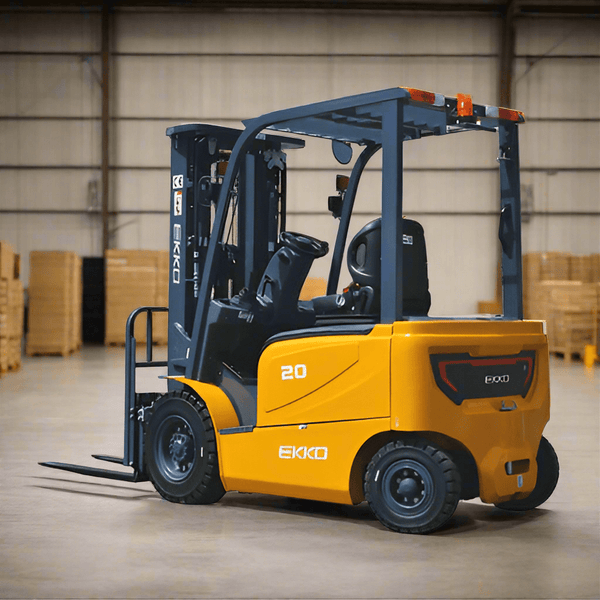
How Thick Does Concrete Need to Be For a Car Lift?
Whether you're freeing up parking space at home or speeding up repairs in a commercial shop, installing a car lift gives you more flexibility, better access, and a safer way to service vehicles without crawling on the ground or jockeying for floor space.
But, it also comes with its fair share of uncertainties. It’s not as simple as finding a lift in your budget and plugging it in. It all starts with figuring out the car lift concrete thickness requirements.
So how thick does concrete need to be for a car lift? We’re here to help you figure out the car lift concrete requirements based on the specific type of lift you’re going with - be it a 2-post lift vs 4-post lift.
For instance, most 2-post lifts need at least 4 to 6 inches of 3,000 PSI concrete. 4-post lifts spread weight across a broader footprint so they might only need 4 inches at 3,000 PSI. Meanwhile, scissor and mid-rise lifts might need even less.
Learn more about the optimal concrete thickness for car lift installation below and other factors you’ll need to consider. But whether you’re looking for the best residential garage car lifts or you’re upgrading your commercial shop, your search for a car lift ends here.
My Garage Supplies is your trusted choice for car lifts from the top manufacturers in the industry. Not only do we have the best selection but we also offer world-class customer service along the way, so get in touch if you want one-on-one support navigating car lift concrete thickness!
Why There Are Car Lift Concrete Requirements
You cannot overlook the importance of concrete thickness for car lift installation. Anchoring a 2-post lift, for example, concentrates several thousand pounds of force into a small footprint beneath each column. The concrete could crack, shift, or fail entirely under load if it isn’t thick enough, strong enough, or stable enough.
Even lifts with broader bases, like 4-post models or scissor lifts, still rely on the slab to stay flat, level, and crack-free under pressure. Skipping this aspect of car lift installation could void your warranty, compromise safety, and lead to costly repairs.
That’s why every lift manufacturer includes specific concrete requirements in their installation guidelines, usually detailing both minimum thickness and compressive strength (PSI). We’ll cover the role each of these plays in safety and stability below.
How Thick Does Concrete Need to Be For a Car Lift?
So, how thick does concrete need to be for a car lift? First, let’s distinguish between PSI and thickness ratings, as people often lump these together or only focus on one or the other, but each is important.
Understanding PSI vs Thickness
Thickness refers to the depth of the slab, while PSI (pounds per square inch) measures the concrete’s compressive strength. In other words, the ability to resist cracking or crushing under load.
You need to factor in both, because a slab that’s thick but weak can still fail. Likewise, a high-PSI slab that’s too thin may not provide enough anchor depth. So, how thick does concrete need to be for a car lift, and how much PSI should it have?
Standard Car Lift Concrete Thickness and PSI Requirements by Lift Type
As we said from the start, different lift styles put different stress loads on the slab. Here are the typical car lift concrete requirements for each category:
- 2-Post Lifts: Minimum 4-6 inches thick at 3,000 PSI. These apply concentrated loads at anchor points and need a strong, stable base, especially for heavier vehicles.
- 4-Post Lifts: Generally safe on 4 inches at 3,000 PSI, since the weight is distributed across four posts. Ideal for storage and light-duty work.
- Scissor & Mid-Rise Lifts: Often require 3.5-4 inches at 3,000 PSI. These lifts spread force more evenly but still depend on level, crack-free concrete.
- Heavy-Duty & Commercial Lifts: May call for 6+ inches with 3,500-4,000 PSI or higher. Some installs also require rebar reinforcement or custom footing pads.
Take these car lift concrete thickness requirements with a grain of salt, and always confirm the actual requirements of your SPECIFIC car lift first. What works for one lift could void the warranty on another.
Manufacturers like Atlas, AMGO, and Tuxedo all publish detailed requirements so you don’t have to play the guessing game. Remember, our customer service team is always on hand to offer one-on-one assistance as well.
How to Check Existing Slab Thickness and PSI
Now, how do you take the required concrete thickness for car lift and confirm your garage or shop meets those standards? If you don’t have construction records on hand, you’ll need to do a bit of work. We recommend verifiying even if you do have these records.
Drill a core sample or use a rotary hammer to measure depth at the planned anchor locations, not just near a wall. As for PSI, you can hire a professional to perform a rebound hammer test or extract a concrete core for lab testing.
Yes, this is a bit more work than you might have planned on. But the key takeaway from this car lift concrete thickness guide is that you cannot gloss over this step.
What if My Slab Doesn’t Meet the Car Lift Concrete Thickness Requirements?
Don’t give up hope if you discover your garage doesn’t meet the car lift concrete requirements. There are ways you can move forward and still install a lift in your space - but it’s going to take a bit more work.
The most common solution is to cut out and repour a reinforced pad or footing at each post location. This is often done for 2-post lifts and allows you to meet thickness and strength specs without tearing out the entire floor.
Let’s say your slab is 3.5” thick but your lift requires 6”. You could simply create two isolated footings under the columns to meet spec. Otherwise, you’d need to pour a new full-depth slab for older concrete, cracks, soft spots to get the surface ready for installation.
The only other option is to consider a portable or mid-rise lift with lower slab demands.
What Else Should You Plan For When Installing a Car Lift?
We know you came here specifically to learn about the optimal concrete thickness for car lift installation. But, car lift concrete thickness is just one of the many moving parts you’ll need to take into account when purchasing and installing these pieces of equipment.
Surface Condition and Flatness
Your concrete slab still needs to be flat, level, and free of surface defects, even if it meets thickness and PSI requirements. The area underneath each post needs to be:
- Free of expansion joints, seams, or visible cracks
- Leveled within ⅛” across anchor points
- Clear of any slope or grade change
Irregular or sloped surfaces can affect column alignment and load balance. Use a long level or laser to verify surface flatness before drilling.
Electrical Requirements
Most 2-post and 4-post lifts run on 220V single-phase power, with motors typically rated around 2.0–2.2 kW. This is to say you’ll need a dedicated 220V circuit with appropriate amperage, a nearby disconnect switch or breaker box, and proper grounding per electrical code.
Some portable or mid-rise lifts may operate on 110V, but always check the motor specs before ordering. Don’t assume your current garage outlets are sufficient. You know what they say about assuming!
Garage Layout and Obstructions
In addition to the car lift concrete requirements you should think about the 4 or 2-post car lift space requirements. Measure everything before you commit to a specific lift and place your order. That means:
- Ceiling height (typically 10-12 ft minimum for 2-post lifts)
- Post-to-post width, including room for vehicle doors to swing open
- Drive-through clearance and space to maneuver around the lift
- Avoidance of ceiling-mounted openers, lighting, or HVAC ductwork
One mistake we see people make when installing a lift is failing to plan around real working space, and just ensuring the lift fits on paper. You need to make sure it’s practical.
Professional Installation vs DIY
While many lifts are marketed as DIY-friendly, anchoring a lift properly and aligning the posts takes more than a drill and a tape measure. It’s worth paying a bit more to have a professional install the lieft for you, whether it’s a symmetric vs asymmetric lift.
They can help confirm slab suitability, handle electrical connections safely, torque anchors to spec, and ensure column plumb and arm symmetry.
That being said, DIY installation is possible if you have the tools, experience, and proper concrete. But, we feel it’s worth it for the peace of mind alone knowing the job is done right the first time around.
Let My Garage Supplies Help You Pick the Perfect Car Lift Today
My Garage Supplies is your go-to destination whether you’re looking for a 2 post car lift or 4 post car lift. We help homeowners and automotive shops alike outfit their garages with the most dependable lifts from trusted manufacturers like Atlas, Tuxedo, and AMGO.
What sets us apart is our focus on helping you make the right decision upfront. We don’t just sell the lifts we have high margins on. We help you choose one that fits your floor, your ceiling height, power setup, workload, and of course, budget.
Not sure if your concrete slab can handle it? We’ll walk you through the specs, interpret the documentation, and make sure you’re not buying something your garage can’t support.
Every lift we carry has been vetted for safety, durability, and day-to-day functionality. So whether you're upgrading a single-bay garage or outfitting a full service shop, reach out now for one-on-one support!
Final Thoughts on Concrete Thickness for Car Lift
So, how thick does concrete need to be for a car lift? We hope this guide to the optimal car lift concrete requirements has left you with complete confidence and clarity about whether or not your flooring is up to par. If not, there are steps you can take to get it there.
Don’t assume. Know your numbers, check your specs, and make sure the floor beneath your lift is built to handle the job. And remember, My Garage Supplies is a click or call away ready to help you make sense of the recommended concrete thickness for car lift installation.
Get in touch today and let’s get your lift installed safely - and done right the first time.



